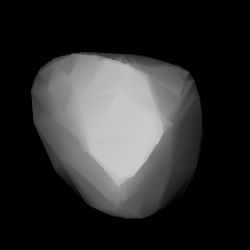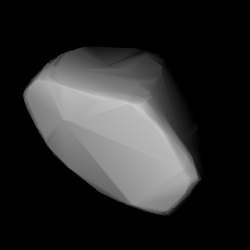Related Research Articles
1156 Kira, provisional designation 1928 DA, is a stony background asteroid from the inner regions of the asteroid belt, approximately 9 kilometers in diameter. It was discovered on 22 February 1928, by German astronomer Karl Reinmuth at Heidelberg Observatory in southwest Germany. Any reference of its name to a person or occurrence is unknown.

1165 Imprinetta, provisional designation 1930 HM, is a carbonaceous Meliboean asteroid from the outer regions of the asteroid belt, approximately 49 kilometers (30 mi) in diameter. It was discovered on 24 April 1930 by Dutch astronomer Hendrik van Gent at the Union Observatory in Johannesburg, South Africa. The asteroid was named after Imprinetta Gent, wife of the discoverer.
2038 Bistro, provisional designation 1973 WF, is a stony asteroid from the inner regions of the asteroid belt, approximately 12 kilometers in diameter. The asteroid was discovered on 24 November 1973, by Swiss astronomer Paul Wild at the Zimmerwald Observatory near Bern, Switzerland. It was named for the Bistro restaurant.
1295 Deflotte, provisional designation 1933 WD, is a carbonaceous asteroid from the outer regions of the asteroid belt, approximately 48 kilometers in diameter. It was discovered on 25 November 1933, by French astronomer Louis Boyer at the Algiers Observatory in Algeria, North Africa. The asteroid was named after the discoverer's nephew.
4282 Endate, provisional designation 1987 UQ1, is an asteroid from the inner regions of the asteroid belt, approximately 10 kilometers in diameter. It was discovered on 28 October 1987, by Japanese astronomers Seiji Ueda and Hiroshi Kaneda at Kushiro Observatory (399) in Japan. It was named for amateur astronomer Kin Endate.
9298 Geake, provisional designation 1985 JM, is a Mitidika asteroid from the central regions of the asteroid belt, approximately 12 kilometers in diameter. It was discovered on 15 May 1985, by American astronomer Edward Bowell at Lowell Observatory's Anderson Mesa Station near Flagstaff, Arizona, United States. The asteroid was named for British astronomer John E. Geake.
1308 Halleria, provisional designation 1931 EB, is a carbonaceous Charis asteroid from the outer regions of the asteroid belt, approximately 43 kilometers in diameter. It was discovered on 12 March 1931, by German astronomer Karl Reinmuth at the Heidelberg-Königstuhl State Observatory. The asteroid was named after Albrecht von Haller a Swiss physician, botanist and poet.
1460 Haltia, provisional designation 1937 WC, is a stony background asteroid from the central regions of the asteroid belt, approximately 8 kilometers in diameter. It was discovered on 24 November 1937, by Finnish astronomer Yrjö Väisälä at the Iso-Heikkilä Observatory in Turku, Finland. The asteroid was named after Halti (Haltia), Finland's highest peak on the border to Norway.
1409 Isko, provisional designation 1937 AK, is a carbonaceous background asteroid from the central regions of the asteroid belt, approximately 35 kilometers in diameter. It was discovered on 8 January 1937, by astronomer Karl Reinmuth at the Heidelberg-Königstuhl State Observatory in southwest Germany. The asteroid was named after Ise Koch, wife of astronomer Fritz Kubach.
6255 Kuma, provisional designation 1994 XT, is a carbonaceous asteroid from the central region of the asteroid belt, approximately 22 kilometers in diameter. It was discovered on 5 December 1994, by Japanese astronomer Akimasa Nakamura at Kuma Kogen Astronomical Observatory on the Island of Shikoku, Japan. It was named after the Japanese town of Kumakōgen.

4547 Massachusetts is a dark background asteroid from the central regions of the asteroid belt, approximately 24 kilometers in diameter. It was discovered on 16 May 1990, by Japanese astronomers Kin Endate and Kazuro Watanabe at the JCPM Sapporo Station on the island of Hokkaido, Japan. The asteroid was named for the U.S. state of Massachusetts.
2043 Ortutay, provisional designation 1936 TH, is a dark asteroid from the outer regions of the asteroid belt, approximately 45 kilometers in diameter. The asteroid was discovered by Hungarian astronomer György Kulin at the Konkoly Observatory, Budapest, on 12 November 1936. It was named after Hungarian ethnographer Gyula Ortutay.
1347 Patria, provisional designation 1931 VW, is a carbonaceous asteroid from the background population of the central asteroid belt, approximately 32 kilometers in diameter. It was discovered on 6 November 1931, by Soviet astronomer Grigory Neujmin at the Simeiz Observatory on the Crimean peninsula. The asteroid was named for the Latin word of fatherland.
1190 Pelagia, provisional designation 1930 SL, is a dark Nysian asteroid from the inner regions of the asteroid belt, approximately 17 kilometers in diameter. It was discovered on 20 September 1930, by Soviet–Georgian astronomer Grigory Neujmin at the Simeiz Observatory on the Crimean peninsula. The asteroid was named after astronomer Pelageya Shajn.
1359 Prieska, provisional designation 1935 OC, is a rare-type carbonaceous asteroid from the outer region of the asteroid belt, approximately 50 kilometers in diameter. It was discovered on 22 July 1935, by English-born South-African astronomer Cyril Jackson at Johannesburg Observatory in South Africa. The asteroid was named after the South African town of Prieska.

1197 Rhodesia, provisional designation 1931 LD, is a dark background asteroid from the outer regions of the asteroid belt, approximately 48 kilometers in diameter. It was discovered on 9 June 1931, by South African astronomer Cyril Jackson at the Union Observatory in Johannesburg. The likely C-type asteroid has a rotation period of 16.1 hours. It was named for Rhodesia, a former British colony and unrecognised state, which is now Zimbabwe.
1646 Rosseland, provisional designation 1939 BG, is a stony asteroid from the inner regions of the asteroid belt, approximately 12 kilometers in diameter. It was discovered on 19 January 1939, by Finnish astronomer Yrjö Väisälä at Turku Observatory in Southwest Finland. It was later named after Norwegian astrophysicist Svein Rosseland.
1258 Sicilia, provisional designation 1932 PG, is a dark background asteroid from the outer regions of the asteroid belt, approximately 44 kilometers in diameter. It was discovered on 8 August 1932, by astronomer Karl Reinmuth at the Heidelberg-Königstuhl State Observatory in southwest Germany. The asteroid was named after the Italian island of Sicily.
1585 Union, provisional designation 1947 RG, is a dark background asteroid from the outer regions of the asteroid belt, approximately 52 kilometers in diameter. It was discovered on 7 September 1947, by South African astronomer Ernest Johnson at the Union Observatory in Johannesburg, South Africa. The asteroid was named after the discovering observatory.
1257 Móra, provisional designation 1932 PE, is an asteroid from the inner regions of the asteroid belt, approximately 15 kilometers in diameter. It was discovered on 8 August 1932, by German astronomer Karl Reinmuth at Heidelberg Observatory in southwest Germany. The asteroid was named after Hungarian astronomer Károly Móra.
References
- 1 2 3 4 "JPL Small-Body Database Browser: 1298 Nocturna (1934 AE)" (2017-05-06 last obs.). Jet Propulsion Laboratory . Retrieved 14 September 2017.
- ↑ "nocturnal" . Oxford English Dictionary (Online ed.). Oxford University Press.(Subscription or participating institution membership required.)
- 1 2 3 Schmadel, Lutz D. (2007). "(1298) Nocturna". Dictionary of Minor Planet Names – (1298) Nocturna. Springer Berlin Heidelberg. p. 107. doi:10.1007/978-3-540-29925-7_1299. ISBN 978-3-540-00238-3.
- 1 2 3 4 5 6 7 "LCDB Data for (1298) Nocturna". Asteroid Lightcurve Database (LCDB). Retrieved 14 September 2017.
- 1 2 3 4 5 Masiero, Joseph R.; Mainzer, A. K.; Grav, T.; Bauer, J. M.; Cutri, R. M.; Nugent, C.; et al. (November 2012). "Preliminary Analysis of WISE/NEOWISE 3-Band Cryogenic and Post-cryogenic Observations of Main Belt Asteroids". The Astrophysical Journal Letters. 759 (1): 5. arXiv: 1209.5794 . Bibcode:2012ApJ...759L...8M. doi:10.1088/2041-8205/759/1/L8. S2CID 46350317 . Retrieved 14 September 2017.
- 1 2 3 4 Tedesco, E. F.; Noah, P. V.; Noah, M.; Price, S. D. (October 2004). "IRAS Minor Planet Survey V6.0". NASA Planetary Data System. 12: IRAS-A-FPA-3-RDR-IMPS-V6.0. Bibcode:2004PDSS...12.....T . Retrieved 22 October 2019.
- 1 2 3 4 Nugent, C. R.; Mainzer, A.; Masiero, J.; Bauer, J.; Cutri, R. M.; Grav, T.; et al. (December 2015). "NEOWISE Reactivation Mission Year One: Preliminary Asteroid Diameters and Albedos". The Astrophysical Journal. 814 (2): 13. arXiv: 1509.02522 . Bibcode:2015ApJ...814..117N. doi:10.1088/0004-637X/814/2/117. S2CID 9341381 . Retrieved 14 September 2017.
- 1 2 3 4 Usui, Fumihiko; Kuroda, Daisuke; Müller, Thomas G.; Hasegawa, Sunao; Ishiguro, Masateru; Ootsubo, Takafumi; et al. (October 2011). "Asteroid Catalog Using Akari: AKARI/IRC Mid-Infrared Asteroid Survey". Publications of the Astronomical Society of Japan. 63 (5): 1117–1138. Bibcode:2011PASJ...63.1117U. doi: 10.1093/pasj/63.5.1117 . (online, AcuA catalog p. 153)
- 1 2 3 4 Nugent, C. R.; Mainzer, A.; Bauer, J.; Cutri, R. M.; Kramer, E. A.; Grav, T.; et al. (September 2016). "NEOWISE Reactivation Mission Year Two: Asteroid Diameters and Albedos". The Astronomical Journal. 152 (3): 12. arXiv: 1606.08923 . Bibcode:2016AJ....152...63N. doi: 10.3847/0004-6256/152/3/63 .
- 1 2 Behrend, Raoul. "Asteroids and comets rotation curves – (1298) Nocturna". Geneva Observatory . Retrieved 14 September 2017.
- 1 2 3 Veres, Peter; Jedicke, Robert; Fitzsimmons, Alan; Denneau, Larry; Granvik, Mikael; Bolin, Bryce; et al. (November 2015). "Absolute magnitudes and slope parameters for 250,000 asteroids observed by Pan-STARRS PS1 - Preliminary results". Icarus. 261: 34–47. arXiv: 1506.00762 . Bibcode:2015Icar..261...34V. doi:10.1016/j.icarus.2015.08.007. S2CID 53493339 . Retrieved 14 September 2017.
- 1 2 "1298 Nocturna (1934 AE)". Minor Planet Center. Retrieved 14 September 2017.